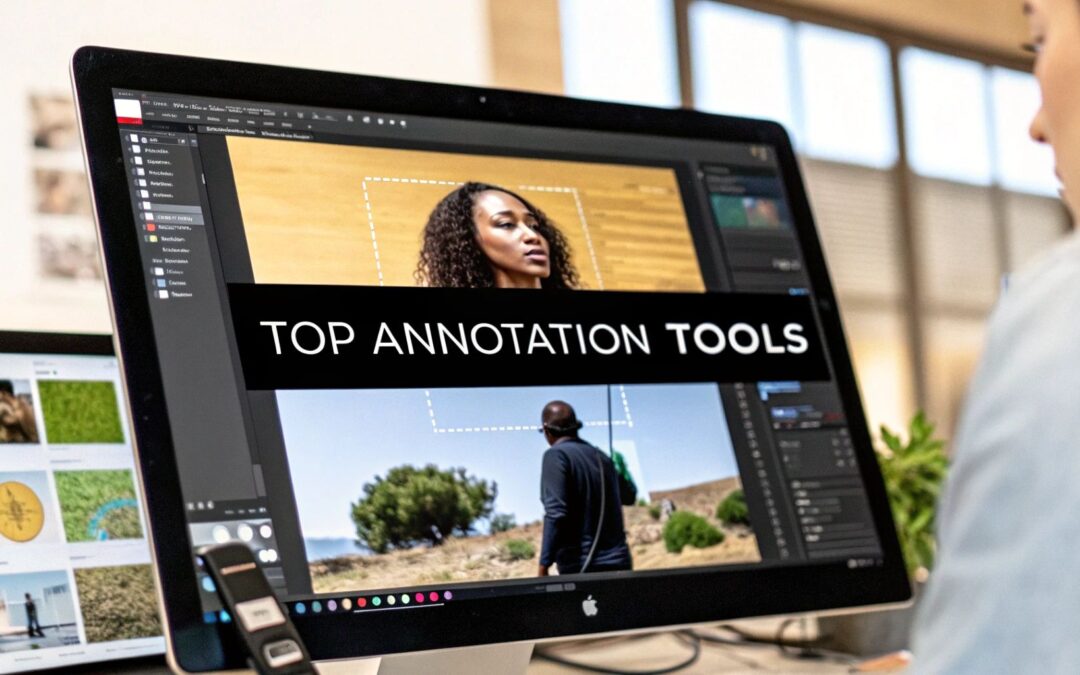High-quality training data is the bedrock of any successful computer vision project. However, creating this data through manual labeling is a complex, time-consuming, and often error-prone process. The right image annotation software is essential for streamlining this workflow, ensuring data accuracy, and accelerating your model's time to production. Without a robust platform, teams face significant bottlenecks, from managing large datasets and collaborating with annotators to maintaining consistent quality control. This is the core problem these tools are built to solve.
This resource guide cuts directly to what you need to know. We provide a detailed analysis of the top 12 image annotation platforms, moving beyond generic feature lists to offer practical insights. You will find an honest assessment of each tool's strengths, weaknesses, and ideal use cases, whether you're a lean startup or a large enterprise AI team.
We explore everything from advanced automation features and data management capabilities to integration options and pricing structures. For each entry, we include screenshots for a quick visual reference and a direct link to the platform. Our goal is simple: to help you efficiently compare the leading options and select the best image annotation software for your specific project requirements, team size, and budget.
1. Zilo Services: Image Annotation
Zilo Services stands out not as a singular piece of image annotation software, but as a comprehensive, fully-managed annotation service provider. It’s an ideal choice for enterprises and startups that prioritize precision, scalability, and expert quality without the overhead of managing an in-house labeling team. Zilo’s core strength lies in its ability to deliver meticulously crafted datasets tailored to complex computer vision and machine learning models.

The platform’s power comes from a potent combination of human expertise and advanced processes. By leveraging a vast, skilled workforce, Zilo ensures that projects ranging from autonomous vehicle systems to medical imaging analysis receive the high-quality, annotated data necessary for robust model performance. A deeper dive into the technological foundations of image annotation reveals the critical role of AI's role in computer vision in enhancing accuracy and efficiency.
Key Strengths & Use Cases
What truly distinguishes Zilo is its breadth of annotation capabilities. The service covers everything from basic bounding boxes and image classification to highly intricate semantic segmentation and polygon annotation. This versatility makes it a powerful partner for diverse applications.
- Autonomous Systems: Ideal for creating training data for self-driving cars and drones, requiring precise object detection (bounding boxes) and environmental understanding (semantic segmentation).
- Retail Analytics: Powers applications like automated checkout and inventory management through accurate product identification and classification.
- Healthcare Imaging: Supports the development of diagnostic AI by providing detailed landmark and polygon annotations on medical scans like X-rays and MRIs.
The service model is built for integration, acting as an end-to-end data partner that can scale with project demands. This is especially beneficial for organizations that need to accelerate their AI development timelines without compromising on data integrity. For a more detailed look into this, Zilo offers insights on why data annotation is critical for AI startups in 2025.
Website: https://ziloservices.com/image-annotation/
2. Encord
Encord is a comprehensive data development platform designed for complex computer vision projects. It excels by integrating powerful AI-assisted labeling tools directly into its workflow, which can dramatically reduce manual annotation time. This makes it a standout piece of image annotation software for teams handling massive datasets that require high levels of accuracy.
The platform's core strength lies in its automation capabilities. Encord claims its AI tools can automate up to 97% of annotations, including bounding boxes, polygons, and key points, with 99% accuracy. This is a significant advantage for large-scale operations in sectors like healthcare, retail, and autonomous vehicles.

Key Features and Considerations
Encord is built for scalability and collaboration, supporting datasets up to 500,000 images and offering an intuitive interface for team projects. However, its advanced feature set and enterprise focus mean its pricing structure may be prohibitive for smaller teams or individual developers. While the user interface is clean, mastering the more advanced customization and model integration features involves a learning curve.
- Best For: Enterprise AI/ML teams and research institutions with large, complex datasets.
- Pricing: Custom pricing based on usage; likely higher-tier for enterprise solutions.
- Limitation: The cost and complexity might be overkill for small-scale projects.
- Website: encord.com
3. V7
V7 is an AI-powered annotation platform designed to automate and scale complex data labeling workflows. It stands out by combining a user-friendly interface with powerful automation, making sophisticated image annotation software accessible to both technical and non-technical users. The platform supports a wide array of data types, including images, video, PDFs, and specialized formats like medical DICOM and multi-spectral imagery.
A key differentiator for V7 is its adaptive AI model, which learns from human annotations in real-time to suggest labels automatically. This "human-in-the-loop" approach significantly accelerates labeling for large datasets, allowing teams to build highly accurate ground truth data more efficiently. The platform is built for real-time collaboration, making it ideal for distributed teams working on intricate projects.
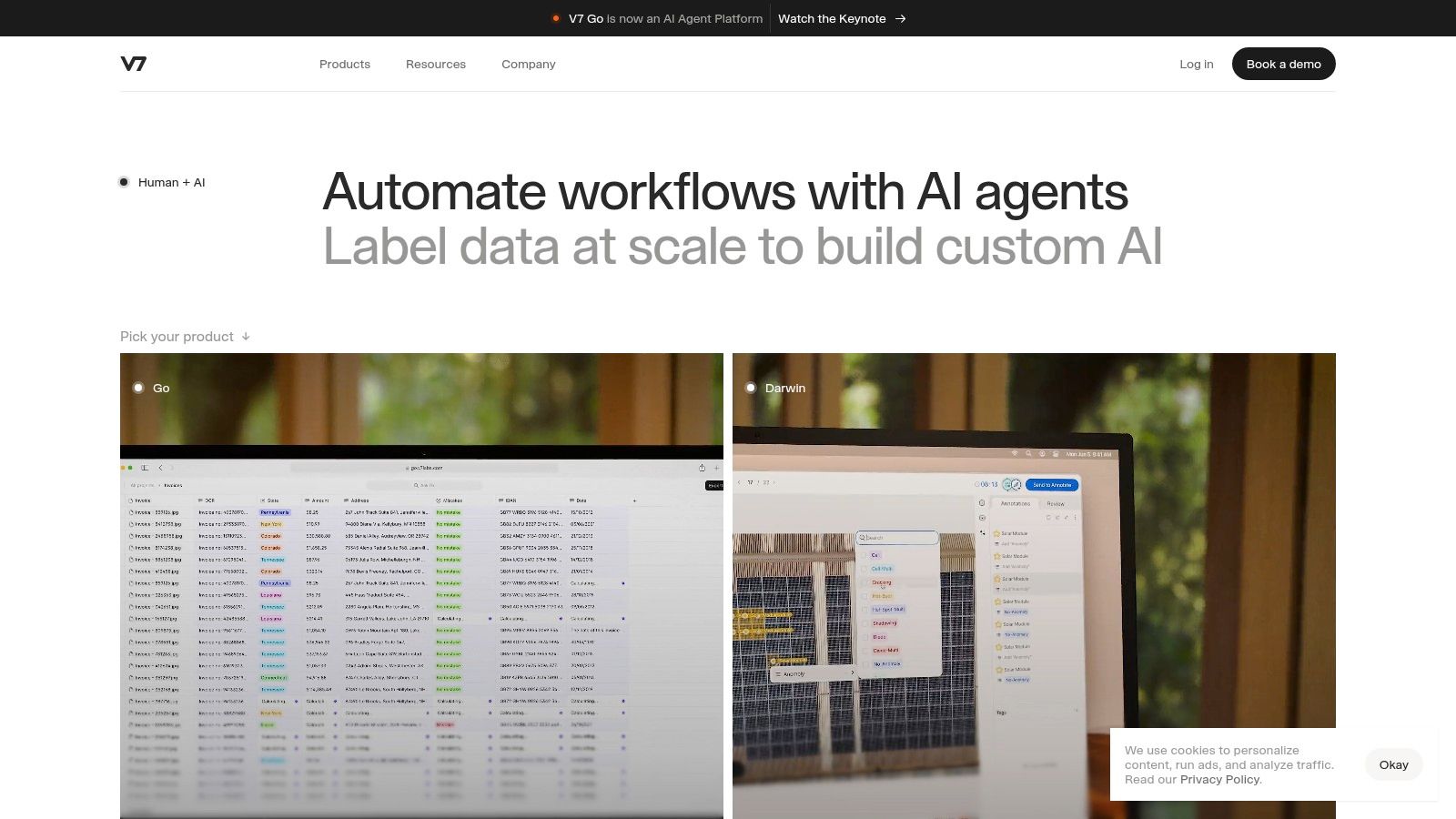
Key Features and Considerations
V7 excels in creating customizable and automated workflows that integrate seamlessly with major machine learning frameworks. While its intuitive design lowers the entry barrier, users have noted occasional performance lags when handling extremely large or complex files. The pricing model, though offering a free trial, can be a considerable investment for smaller organizations or startups.
- Best For: Teams in healthcare, life sciences, and research needing to annotate diverse and complex file types.
- Pricing: Tiered plans available; a free 14-day trial is offered. Paid plans can be expensive.
- Limitation: The cost of advanced plans might be prohibitive for small-scale projects or individual developers.
- Website: v7labs.com
4. Labelbox
Labelbox stands out as a versatile data annotation platform that excels in managing the entire data preparation lifecycle for machine learning. It provides a collaborative environment for teams to label images, videos, and text with a strong emphasis on workflow automation and quality control. This makes it an ideal piece of image annotation software for organizations looking to streamline complex labeling pipelines from start to finish.
The platform is recognized for its intuitive interface and powerful AI-assisted labeling features, which help accelerate the annotation process for bounding boxes and polygons. Its built-in quality assurance tools, like consensus scoring and review workflows, ensure data accuracy, which is critical for training reliable AI models. Labelbox is engineered to integrate smoothly with popular machine learning frameworks, simplifying the MLOps cycle.
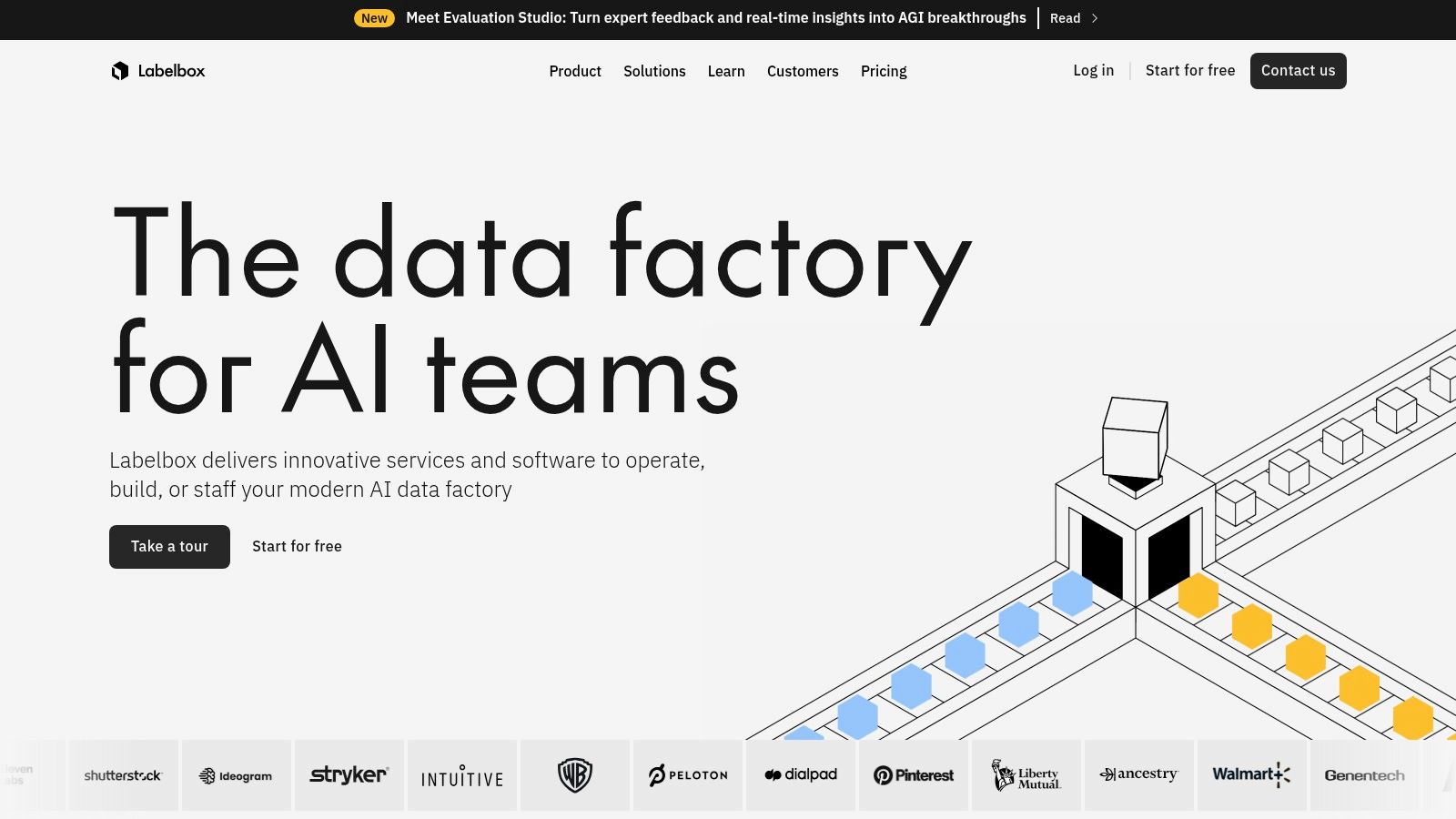
Key Features and Considerations
Labelbox’s strength is its user-friendly, customizable workflow engine that allows teams to design and manage intricate annotation projects efficiently. While it offers a generous free tier for individuals and small projects, its advanced features are geared toward enterprise-level needs. Some users have noted limitations when working with extremely high-resolution or multichannel images, which could be a factor for specialized use cases like medical or satellite imaging.
- Best For: AI/ML teams needing a collaborative platform with strong workflow management and quality control.
- Pricing: Free tier available; custom enterprise plans for advanced features and scale.
- Limitation: May struggle with performance on very high-resolution images and has limited multichannel image support.
- Website: labelbox.com
5. SuperAnnotate
SuperAnnotate is a comprehensive annotation platform designed for high-volume image and video data, combining powerful AI-assisted tools with robust team management features. It stands out by providing a unified solution that streamlines the entire data pipeline from annotation to quality assurance and model evaluation. This makes it a top-tier piece of image annotation software for enterprises that need to manage complex projects with speed and precision.
The platform excels at accelerating the labeling process through features like smart segmentation, AI-powered suggestions for bounding boxes, and transfer learning capabilities. This allows teams to build high-quality training datasets faster while maintaining strict control over annotation standards. Its user-friendly interface is designed to reduce the annotator learning curve, even with advanced tools.
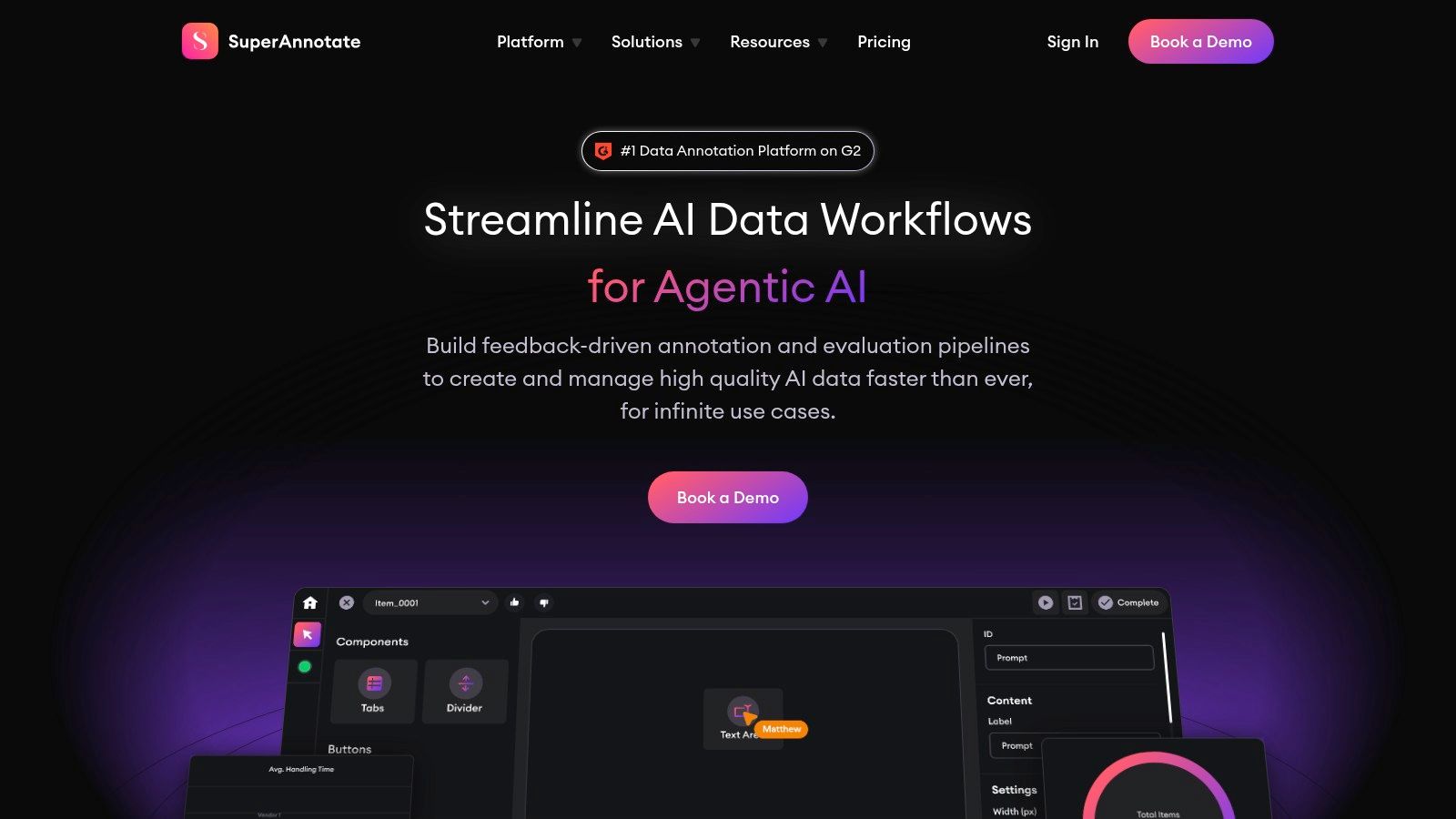
Key Features and Considerations
SuperAnnotate is built for collaborative enterprise environments, offering detailed analytics, role-based access control, and seamless integration with machine learning frameworks. While its advanced toolset and strong customer support are significant advantages, the pricing structure can be a hurdle for smaller teams or individual developers. Some users also report a learning curve when mastering the more intricate features for custom workflows. Companies looking to scale their operations can also learn more about SuperAnnotate and similar managed service providers on Zilo Services.
- Best For: Enterprise AI/ML teams, data operations managers, and companies requiring high-quality, large-scale annotation.
- Pricing: Custom enterprise plans; a free 14-day trial is available to explore features.
- Limitation: Can be cost-prohibitive for startups and small-scale projects.
- Website: superannotate.com
6. CVAT (Computer Vision Annotation Tool)
CVAT is a powerful, free, and open-source annotation tool originally developed by Intel. It stands out by offering a robust, web-based platform that brings enterprise-level features like collaborative and semi-automatic annotation to the open-source community. This makes it an exceptional piece of image annotation software for teams needing a customizable solution without the high costs of commercial platforms.
The tool’s core value is its flexibility. It supports a wide range of annotation tasks for both images and videos, including bounding boxes, polygons, and key points. Its semi-automatic features, which leverage deep learning models, can significantly speed up the labeling process by suggesting annotations, making it highly efficient for academic research and startups on a budget.

Key Features and Considerations
CVAT is designed for technical users who value control and customization. While it offers a hosted cloud version for easier access, its true power is unlocked when self-hosted, allowing for deep integration with existing ML workflows. However, this requires significant technical expertise for setup, maintenance, and scaling. The user interface is functional but may feel less polished than some commercial alternatives.
- Best For: Academic researchers, startups, and development teams with the technical skills to manage a self-hosted environment.
- Pricing: Free and open-source; a paid cloud version is available for managed hosting.
- Limitation: Requires technical knowledge for self-hosting and can be difficult to scale for massive, enterprise-level datasets.
- Website: cvat.ai
7. LabelMe
LabelMe is a classic open-source annotation tool created by the MIT Computer Science and Artificial Intelligence Laboratory. Its primary strength lies in its simplicity and accessibility, making it an excellent piece of image annotation software for academic research, small-scale projects, and educational purposes. The platform is web-based, allowing users to start annotating directly in a browser without complex setup procedures.
What sets LabelMe apart is its straightforward focus on fundamental annotation tasks. It excels at polygon-based labeling but also supports basic shapes like rectangles, circles, lines, and points. While it lacks the advanced automation and collaborative features of enterprise-grade platforms, its lightweight nature and free, open-source model make it an invaluable resource for individuals and teams who need a no-frills, effective tool for creating computer vision datasets.
Key Features and Considerations
LabelMe is designed for ease of use and quick deployment. Its web interface is intuitive, and it also offers an offline desktop application for users who need to work without an internet connection. Annotations can be exported in standard formats like Pascal VOC and COCO, ensuring compatibility with most machine learning frameworks. However, the tool does not support real-time collaboration or sophisticated project management features, which can be a limitation for larger, distributed teams.
- Best For: Academic researchers, students, and developers working on small to medium-sized projects.
- Pricing: Completely free and open-source.
- Limitation: Lacks advanced features like AI-assisted labeling and real-time team collaboration.
- Website: labelme.csail.mit.edu
8. VoTT (Visual Object Tagging Tool)
VoTT (Visual Object Tagging Tool) is a free, open-source annotation and labeling tool developed by Microsoft. It is designed to be a straightforward solution for generating datasets for object detection models, making it a valuable piece of image annotation software for developers, students, and researchers on a budget. The tool supports labeling objects in both static images and video frames, offering a simple yet effective workflow.
Its main appeal is its accessibility and direct integration capabilities. VoTT allows users to connect to local file systems as well as cloud storage providers like Azure Blob Storage and Bing Image Search for sourcing and storing data. This flexibility simplifies the data pipeline for those already working within the Microsoft ecosystem or needing a no-cost entry point into computer vision.
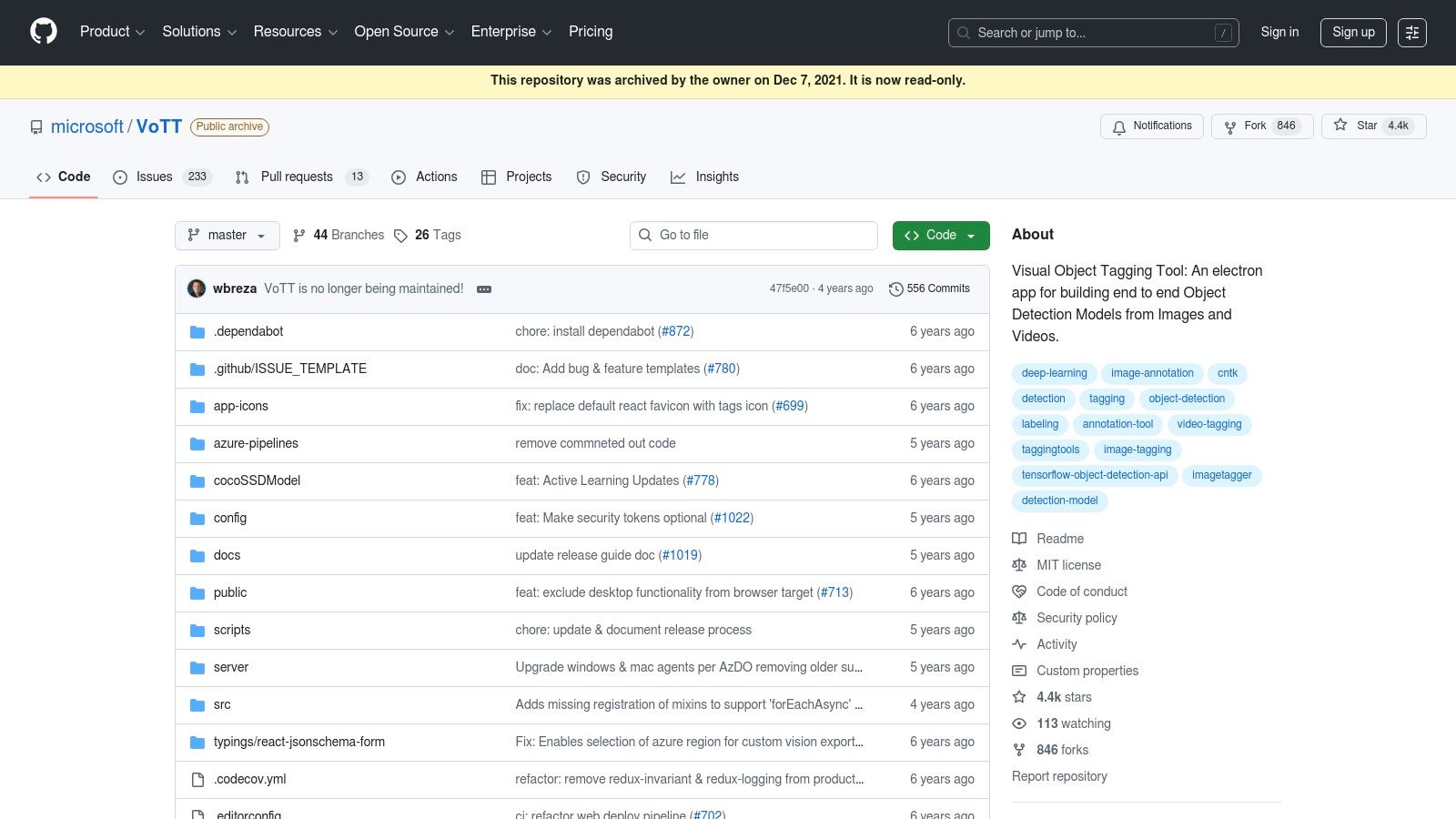
Key Features and Considerations
VoTT's user-friendly interface lowers the barrier to entry for creating labeled datasets. It exports annotations in multiple formats compatible with popular machine learning frameworks, including TensorFlow (TFRecord) and YOLO. However, its feature set is less advanced compared to commercial platforms, lacking sophisticated automation or collaborative tools. Development has also slowed significantly, meaning it may not receive regular updates or support.
- Best For: Individuals, academic researchers, and small teams needing a free tool for basic object detection labeling.
- Pricing: Completely free and open-source.
- Limitation: Lacks advanced annotation features and active development has largely ceased.
- Website: github.com/microsoft/VoTT
9. Roboflow
Roboflow positions itself as an end-to-end computer vision platform, streamlining the entire workflow from image collection and annotation to model training and deployment. It stands out by integrating powerful dataset management tools directly with its labeling interface, making it an excellent piece of image annotation software for developers who need to quickly iterate on their models. The platform emphasizes ease of use and rapid prototyping, allowing users to go from raw images to a trained model with minimal friction.
Its key differentiator is the focus on the complete model development lifecycle. Roboflow offers built-in data augmentation and preprocessing, which can generate thousands of training image variations from a small base set. This helps improve model robustness and reduces the need for extensive manual data collection, a significant advantage for startups and teams on tight deadlines.
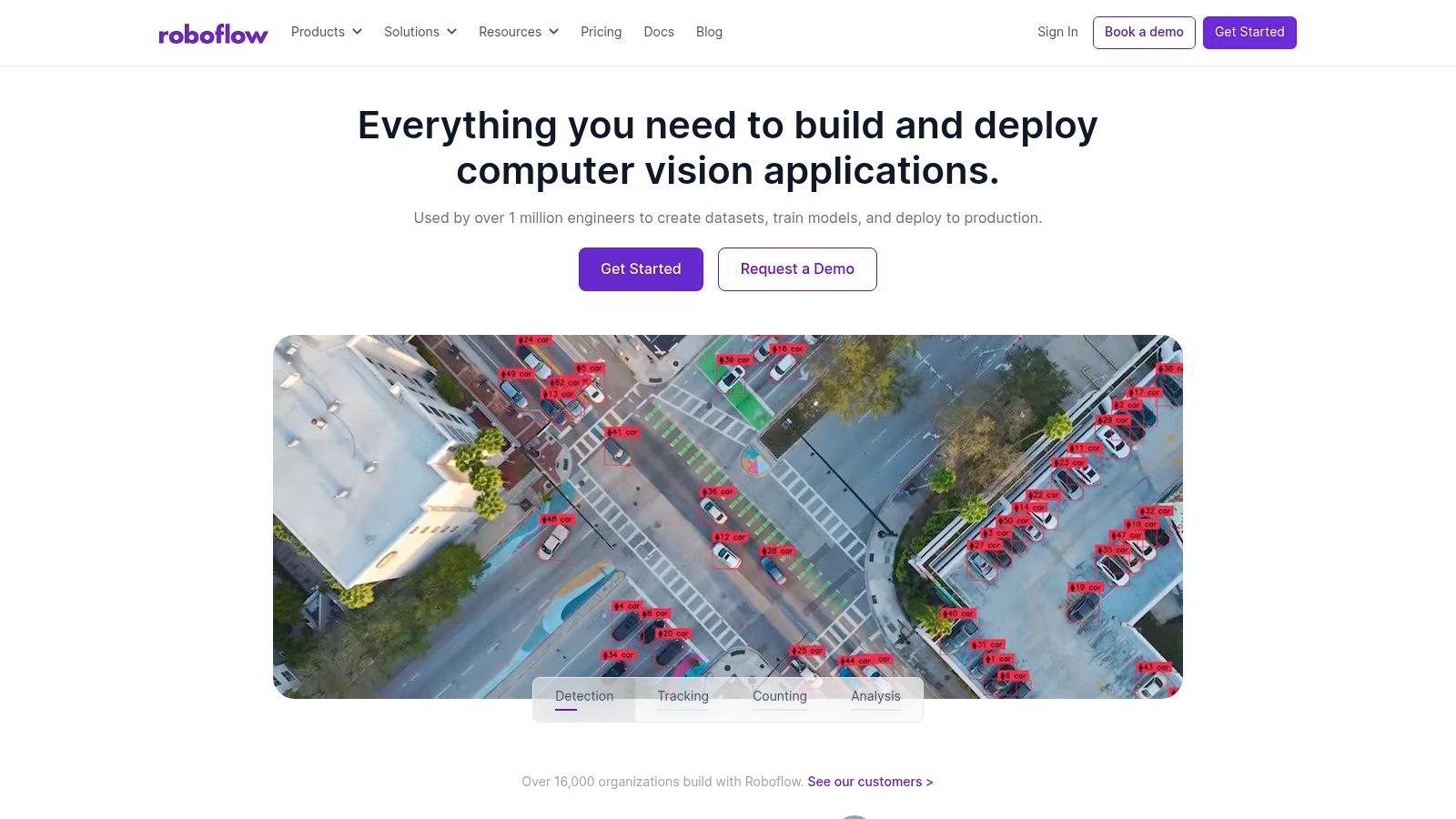
Key Features and Considerations
Roboflow is lauded for its user-friendly interface and comprehensive documentation, making it accessible even for those new to computer vision. However, while its free tier is generous for public projects, the paid plans can become costly as dataset size and team collaboration needs grow. Users have also noted some limitations in labeling efficiency for highly complex or nuanced annotation tasks compared to more specialized, enterprise-grade tools.
- Best For: Developers, students, and small to mid-sized teams looking for an all-in-one platform for rapid model development.
- Pricing: Offers a free tier for public projects; paid plans start at $249/month.
- Limitation: Paid plans can be expensive for very large-scale private projects, and annotation tools may lack advanced features for hyper-specific tasks.
- Website: roboflow.com
10. Scale AI
Scale AI is an industry leader in providing high-quality training data, combining advanced AI-assisted tools with a robust human-in-the-loop system. It specializes in handling complex, large-scale annotation projects that demand exceptional precision, making it a go-to piece of image annotation software for enterprises developing cutting-edge AI, particularly in autonomous driving and robotics.
The platform’s main differentiator is its ability to deliver production-grade data at immense scale. It supports a wide range of annotation types, from simple 2D bounding boxes to highly complex 3D sensor fusion and semantic segmentation. This focus on quality and scalability, backed by customizable workflows and stringent quality control, ensures that the resulting datasets are reliable for training sophisticated models. This approach is fundamental for organizations aiming to improve their data-driven decision-making.
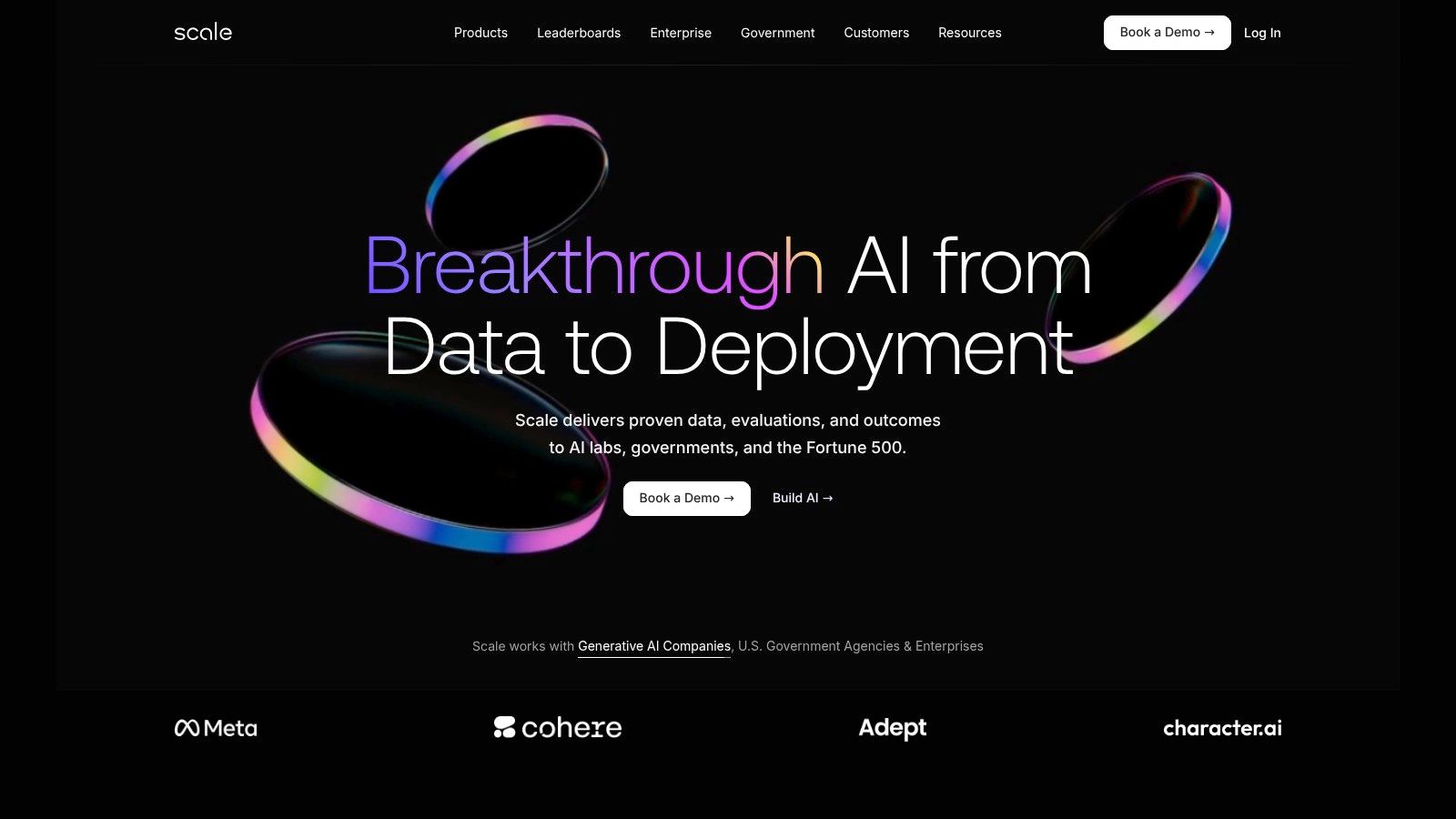
Key Features and Considerations
Scale AI is engineered for enterprises that cannot compromise on data accuracy. Its integration capabilities with major cloud platforms and customizable quality assurance steps make it a powerful part of the MLOps pipeline. However, this premium, service-oriented approach comes at a higher cost compared to self-serve platforms. The user interface, while powerful, can also present a steeper learning curve for teams unfamiliar with such comprehensive data annotation ecosystems.
- Best For: Enterprise AI teams, especially in the autonomous vehicle and robotics sectors requiring high-precision 2D/3D data.
- Pricing: Custom enterprise pricing, generally positioned at a premium tier due to its managed service component.
- Limitation: The cost and service-focused model may not be suitable for smaller teams or academic research with limited budgets.
- Website: scale.com
11. Dataloop
Dataloop is a unified annotation and data management platform built to handle the entire AI lifecycle, from data labeling to model evaluation and deployment. It stands out by providing a comprehensive, MLOps-integrated environment that supports continuous AI development workflows. This makes it an excellent piece of image annotation software for teams looking to manage complex, end-to-end projects within a single system, rather than juggling multiple tools.
The platform excels at accelerating labeling tasks with its AI-assisted tools for both images and videos. Its focus on a production-oriented pipeline allows teams to build and deploy models faster, with robust quality control and collaboration features ensuring data accuracy at scale. Dataloop is engineered for large datasets and intricate project requirements, making it a powerful choice for enterprise AI initiatives.
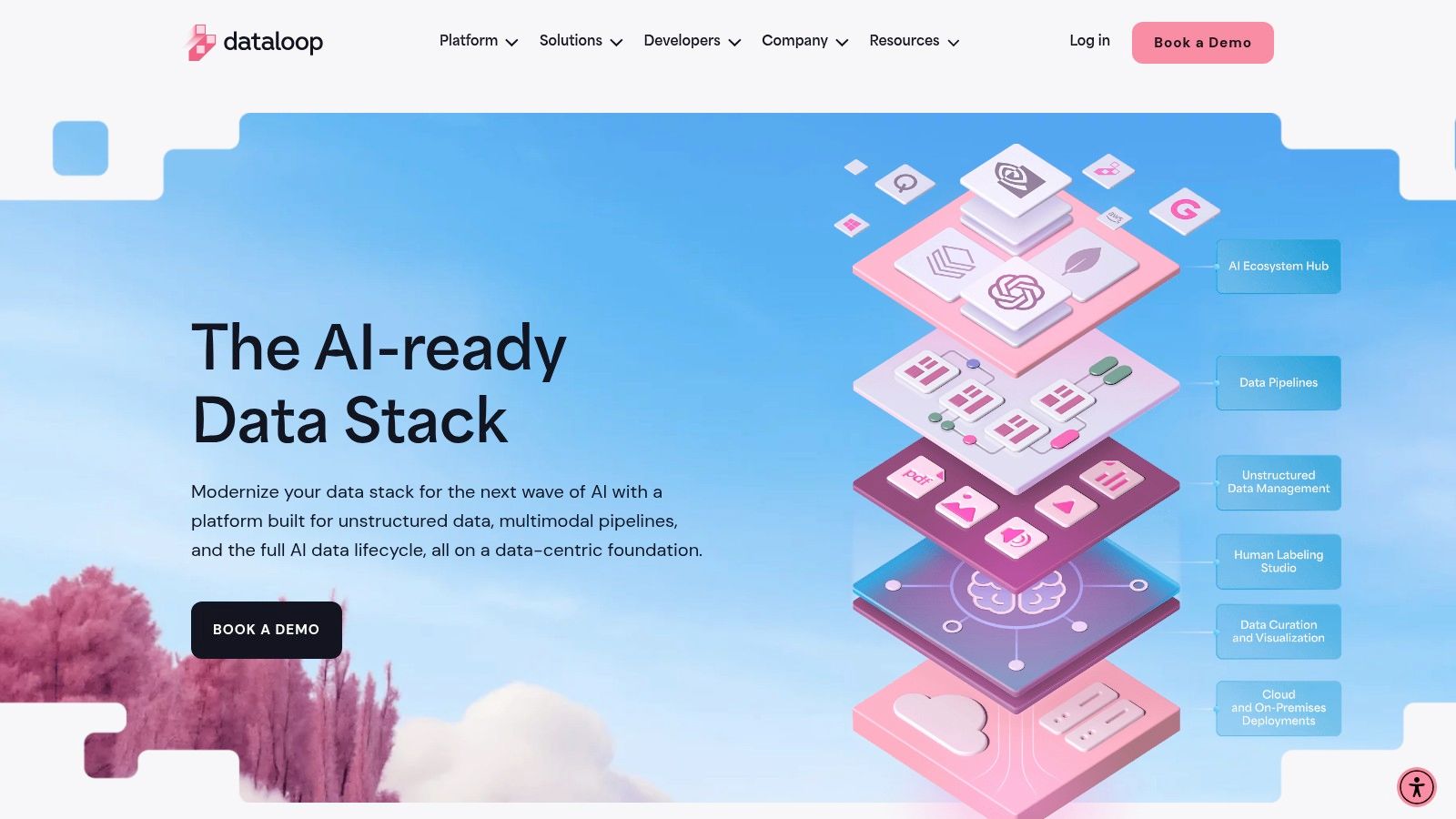
Key Features and Considerations
Dataloop is designed for scalability and operational efficiency, featuring role-based access and task assignment for streamlined team collaboration. While its end-to-end workflow support is a major advantage, some users have noted that its API may have limitations for highly customized or advanced integrations. Additionally, there can be delays in notifications regarding pipeline issues, which may impact rapid-response workflows.
- Best For: Enterprise teams in retail, healthcare, and finance managing large-scale, end-to-end AI projects.
- Pricing: Custom enterprise plans; offers a free tier for individuals and small teams.
- Limitation: The API might not be flexible enough for all advanced integration needs.
- Website: dataloop.ai
12. Playment
Playment is a fully managed data labeling platform specializing in delivering high-quality, human-powered annotations for complex computer vision models. It carves out a niche by focusing on challenging domains like autonomous driving and geospatial analysis, making it a powerful piece of image annotation software for enterprises that cannot compromise on data accuracy.
The platform's core value is its robust, human-in-the-loop managed service. Playment takes on the entire annotation workflow, from workforce management to multi-layered quality control, ensuring that the final labeled datasets meet stringent accuracy requirements. This service-oriented approach is ideal for teams needing to scale large projects without managing an in-house labeling team.
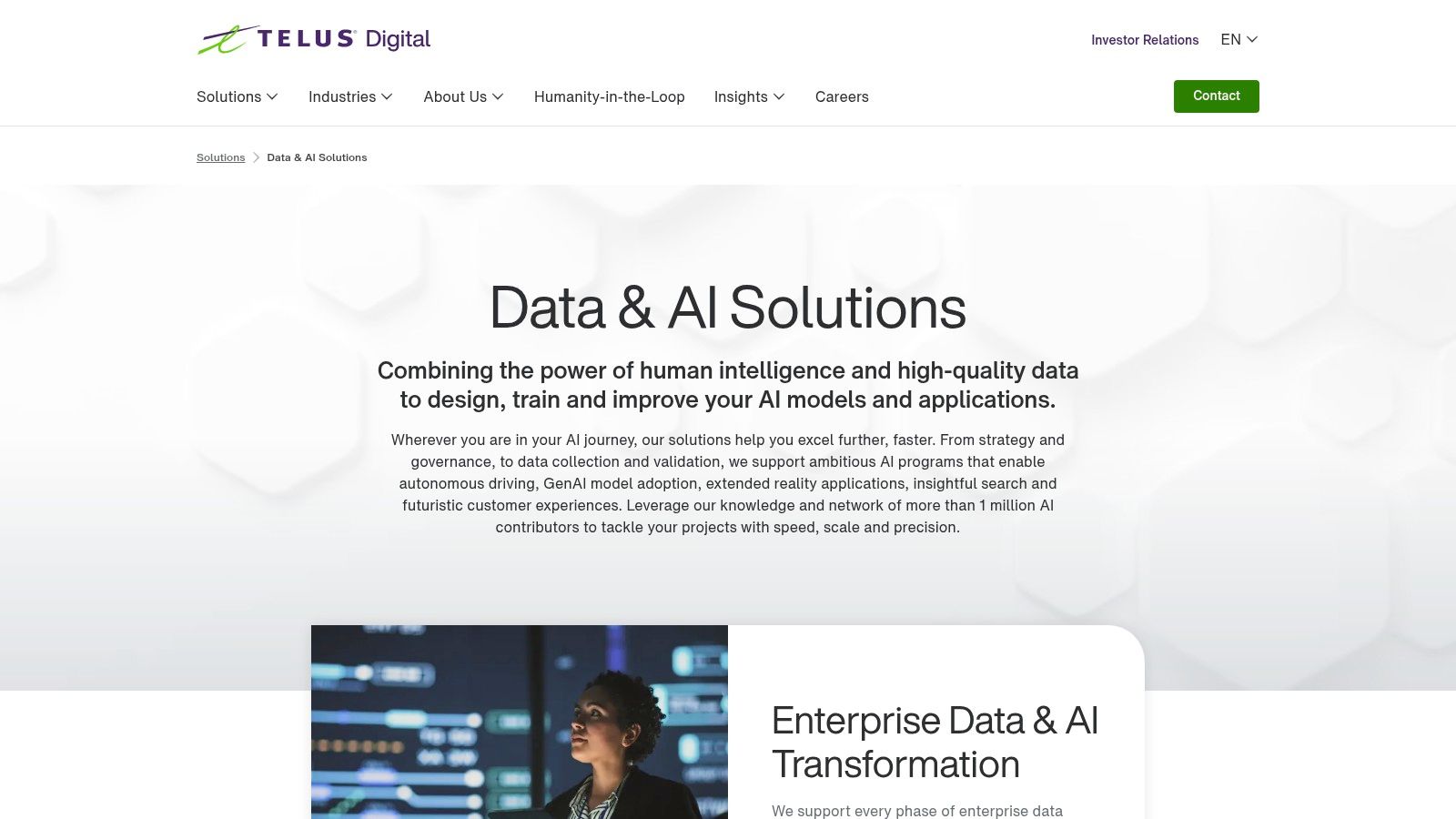
Key Features and Considerations
Playment supports a wide range of data types, including intricate 2D and 3D sensor fusion annotations like LiDAR point clouds, which is critical for autonomous vehicle systems. Its strength lies in its scalability and quality assurance processes. However, as a fully managed solution, it comes at a higher cost compared to self-service tools, and customization options for the annotation interface itself may be more limited.
- Best For: Companies in autonomous driving, robotics, and mapping needing highly accurate, large-scale data labeling.
- Pricing: Custom enterprise pricing, reflecting its managed service model.
- Limitation: The managed service approach and associated cost are not suitable for small teams or academic projects.
- Website: playment.io
Image Annotation Tools Feature Comparison
| Service | Core Features/Characteristics | User Experience/Quality ★ | Value Proposition 💰 | Target Audience 👥 | Unique Selling Points ✨ |
|---|---|---|---|---|---|
| Image Annotation (Zilo AI) | Bounding boxes, polygon, landmark, classification, segmentation | Expert quality, scalable, 10M+ data points ★★★★☆ | Flexible staffing, end-to-end AI support 💰💰 | Enterprises needing robust, multilingual AI data 👥 | Deep industry expertise, multilingual, scalable 🏆 |
| Encord | AI-assisted labeling (97% auto), bounding boxes, polygons | Intuitive UI, collaborative, 99% accuracy ★★★★☆ | Premium pricing for teams 💰💰 | Teams with large complex datasets 👥 | Custom model integration, high automation ✨ |
| V7 | AI-assisted image/video/PDF annotation, real-time collaboration | User-friendly, multi-format support ★★★☆☆ | Paid plans can be pricey 💰💰 | Non-technical users & enterprises 👥 | Supports medical & multispectral images ✨ |
| Labelbox | AI-assisted, bounding boxes, polygons, collaborative tools | Custom workflows, quality assurance ★★★★☆ | Free tier for small projects 💰 | Teams needing collaboration & QA 👥 | Consensus scoring, review workflows ✨ |
| SuperAnnotate | AI-assisted, bounding boxes, segmentation, team collaboration | User-friendly, strong support ★★★★☆ | Trial available, pricey for small teams 💰 | Enterprise & team projects 👥 | Advanced annotation tools, scalable workflows ✨ |
| CVAT | Free, open-source, semi-auto annotation, collaborative | Highly customizable, active community ★★★☆☆ | Free, technical setup required 💰 | Developers with technical skills 👥 | Open-source, deep learning integration ✨ |
| LabelMe | Open-source, polygon & basic shapes, exports VOC/COCO formats | Lightweight, easy to use ★★★☆☆ | Free, no collaboration 💰 | Small projects, education 👥 | Offline app, simple UI ✨ |
| VoTT | Free, open-source, image/video labeling, cloud/local storage | User-friendly, supports video ★★★☆☆ | Free, slow updates 💰 | Developers needing basic annotation 👥 | Cross-platform, storage integrations ✨ |
| Roboflow | Bounding boxes, polygons, dataset mgmt, APIs | Comprehensive, good support ★★★★☆ | Free tier, can get expensive 💰 | Developers & data scientists 👥 | Dataset preprocessing, augmentation ✨ |
| Scale AI | AI-assisted + human-in-loop, 2D/3D bounding boxes, workflows | Robust quality, scalable ★★★★☆ | Higher cost 💰💰 | Enterprises needing high precision 👥 | Complex tasks, strong quality control 🏆 |
| Dataloop | AI-assisted, images/videos, collaboration, MLOps integration | Scalable, end-to-end AI workflows ★★★★☆ | API limits, delayed alerts 💰 | Large-scale AI projects 👥 | MLOps integration, quality control ✨ |
| Playment | 2D/3D (LiDAR), human-in-loop QC, scalable workflows | Expert quality assurance ★★★★☆ | Premium pricing 💰💰 | Autonomous driving, geospatial enterprises 👥 | Complex annotation specialization 🏆 |
Final Thoughts
Navigating the expansive landscape of image annotation software can feel daunting, but the right choice ultimately hinges on your project's specific DNA. Throughout this guide, we've explored a diverse range of platforms, from open-source powerhouses like CVAT and LabelMe to comprehensive, enterprise-grade solutions such as Scale AI, Labelbox, and Encord. Each tool offers a unique blend of capabilities tailored to different scales, budgets, and technical requirements.
The key takeaway is that there is no single "best" image annotation software; there is only the best fit for your unique circumstances. A small research team might find the flexibility and cost-effectiveness of an open-source tool like VoTT perfectly adequate, while a large enterprise developing a complex autonomous driving system will require the robust project management, quality control, and scalable workforce features offered by platforms like V7 or Dataloop.
How to Choose the Right Tool for Your Project
To make an informed decision, move beyond feature lists and focus on your core operational needs. Consider these critical factors before committing to a platform:
- Project Scale and Complexity: How many images do you need to annotate, and how intricate are the annotations? Your answer will determine whether a simple tool suffices or if you need a platform built for managing millions of data points with sophisticated quality assurance workflows.
- Team Structure and Collaboration: Are you a solo developer, a small internal team, or a distributed group of annotators? Look for features that match your collaborative needs, such as role-based access control, real-time feedback loops, and performance analytics.
- Integration and Automation: How will the software fit into your existing MLOps pipeline? Prioritize tools with strong APIs, SDKs, and native integrations (like Roboflow's seamless model training connection) to minimize friction and automate data flow.
- Data Security and Compliance: For sensitive industries like healthcare or finance, data security is non-negotiable. Scrutinize each vendor's compliance certifications (e.g., HIPAA, GDPR, SOC 2) and on-premise deployment options.
Furthermore, as the field of image annotation software evolves, understanding strategies for securing technology grants can be crucial for developers and organizations looking to fund their next innovative project. This can provide the necessary capital to invest in premium tools that accelerate development.
Ultimately, the journey from raw data to a high-performing AI model is built on a foundation of quality annotations. The image annotation software you choose is not just a utility; it's a strategic asset that directly impacts your model's accuracy, your team's efficiency, and your project's overall success. We encourage you to leverage the free trials and demos offered by many of these platforms to gain hands-on experience and validate which solution truly aligns with your vision.
Ready to bypass the complexities of in-house data labeling and accelerate your AI development? Zilo AI offers expert, fully-managed data annotation services, delivering pixel-perfect datasets tailored to your project's unique requirements. Let our team of skilled professionals handle the tedious work so you can focus on building groundbreaking models. Visit Zilo AI to discover how we can become your trusted data partner.

